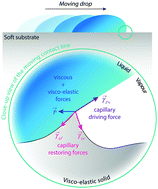Nonlinear theory of wetting on deformable substrates
Abstract
The spreading of a liquid over a solid material is a key process in a wide range of applications. While this phenomenon is well understood when the solid is undeformable, its “soft” counterpart is still misunderstood and no consensus has been reached with regard to the physical mechanisms ruling the spreading of liquid drops over soft deformable materials. In this work we provide a theoretical framework, based on the nonlinear theory of discontinuities, to describe the behavior of a triple line on a soft material. We show that the contact line motion is opposed both by nonlinear localized capillary and visco-elastic forces. We give an explicit analytic formula relating the dynamic contact angle of a moving drop to its velocity for arbitrary rheology. We then specialize this formula to the experimentally relevant case of elastomers with the Chasset–Thirion (power-law) type of rheologies. The theoretical prediction is in very good agreement with experimental data, without any adjustable parameters. We then show that the nonlinear force balance presented in this work can also be used to recover classical models of wetting. Finally we provide predictions for the dynamic behavior of the yet largely unexplored case of a viscous drop spreading over a soft visco-elastic material and predict the emergence of a new form of apparent hysteresis.



 Please wait while we load your content...
Please wait while we load your content...